Welcome to the wonderful world of pineapple cultivation! Growing your own pineapples is a fun and rewarding experience that not only provides you with delicious and healthy fruit, but also allows you to connect with nature and learn about the fascinating process of plant growth. From selecting the perfect pineapple top to caring for your plant through each stage of development, the journey of growing your own pineapples is sure to be filled with excitement and challenges. However, you will ultimately reap the sweet rewards of your labor! So, whether you’re a seasoned gardener or just starting out, let’s explore the wondrous world of pineapple cultivation! Keep reading for your complete guide on how to grow pineapples!

The journey of growing your own pineapples is sure to be filled with excitement and challenges. However, you will ultimately reap the sweet rewards of your labor!
©5 second Studio/Shutterstock.com
What is a Pineapple?
A pineapple (Ananas comosus) is a tropical fruit indigenous to South America. Pineapples are now widely cultivated in many parts of the world, including Hawaii, Thailand, and the Philippines. The fruit is known for its distinctive appearance, which features a spiky, rough skin and a tuft of spiky green-to-brown leaves at the top. Inside, the fruit is composed of juicy, sweet, tangy flesh that is rich in nutrients like vitamin C and manganese. Pineapples are consumed fresh or canned, and are used in a variety of dishes, like desserts, smoothies, and savory dishes like sweet and sour chicken. In addition to its culinary uses, pineapple is valued for its medicinal properties and is believed to have anti-inflammatory and digestive benefits.
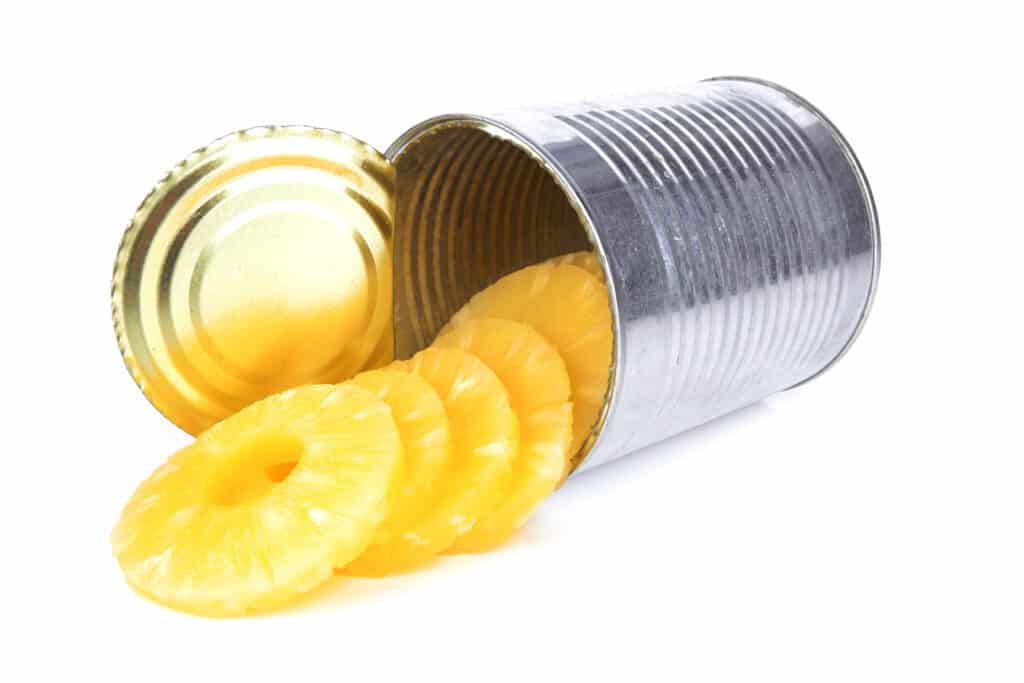
Pineapples are consumed fresh or canned, and are used in a variety of dishes.
©Sergiy Kuzmin/Shutterstock.com
How to Grow Pineapples: Selecting a Variety
There are many different varieties of pineapples, but the most commonly cultivated varieties are the Smooth Cayenne, the Queen, and the Red Spanish.
The most widely grown variety is the Smooth Cayenne. It iss known for its large size, sweet flavor, and low acidity. It is commonly used for canning and juicing. Smooth Cayenne pineapples are the variety most often available in U.S. grocery stores.
The Queen, or Queen Victoria pineapple is smaller and sweeter than the Smooth Cayenne, and has a delicate flavor and aroma. It is often consumed fresh.
The Red Spanish pineapple has a slightly tangy flavor and is often used for making juice or as a garnish. It is also popular for its ornamental value due to its striking red and green coloration.
Other less common pineapple varieties include the Sugarloaf, which is long and conical in shape and has a sweet flavor, and the Pernambuco, which has a tangy flavor and is popular in Brazil.
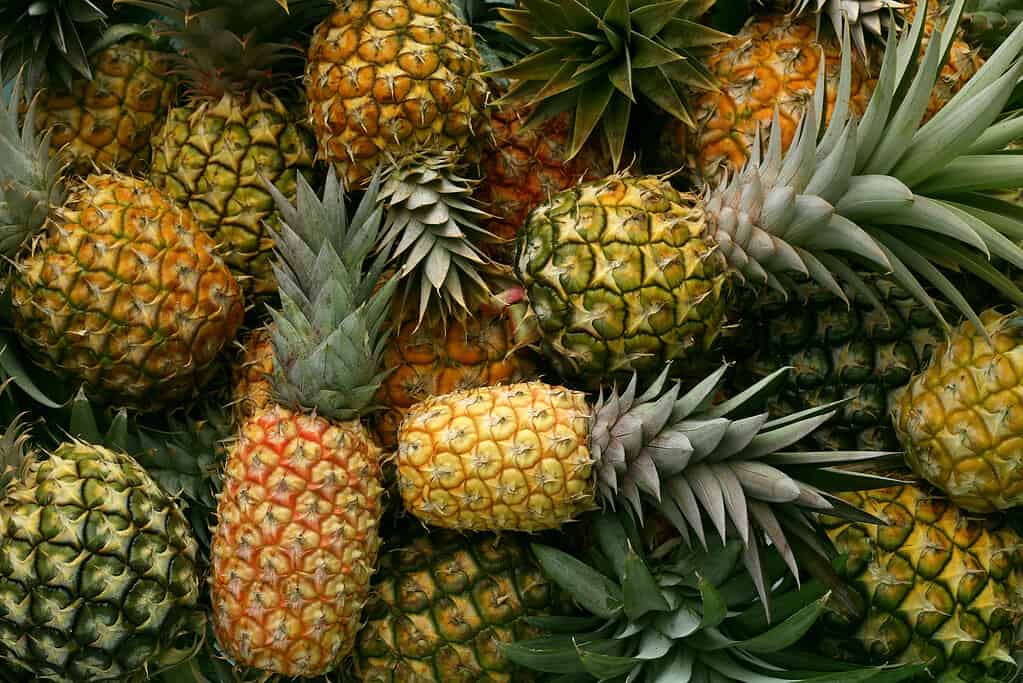
There are many different varieties of pineapples, but the most commonly cultivated varieties are the Smooth Cayenne, the Queen, and the Red Spanish.
©Shulevskyy Volodymyr/Shutterstock.com
How to Grow Pineapples: Requirements
Pineapples are tropical plants that require warm temperatures. They cannot tolerate frost. Therefore, they can only be grown outdoors in USDA Hardiness Zones 11 and 12, which have a minimum temperature range of 40-50°F (4.4-10°C) and 50-60°F (10-15.6°C), respectively. (You can learn which USDA Hardiness Zone you garden in here.) Hawaii is a prime location for growing pineapples due to its warm tropical climate and rich volcanic soil. In fact, Hawaii is the only U.S. state in which pineapples can be grown outdoors. Pineapples are also grown in parts of Thailand, the Philippines, and Central and South America. However, pineapples can be grown as houseplants or in greenhouses in cooler climates. With proper care, they can thrive and produce fruit even in areas out of their natural range.
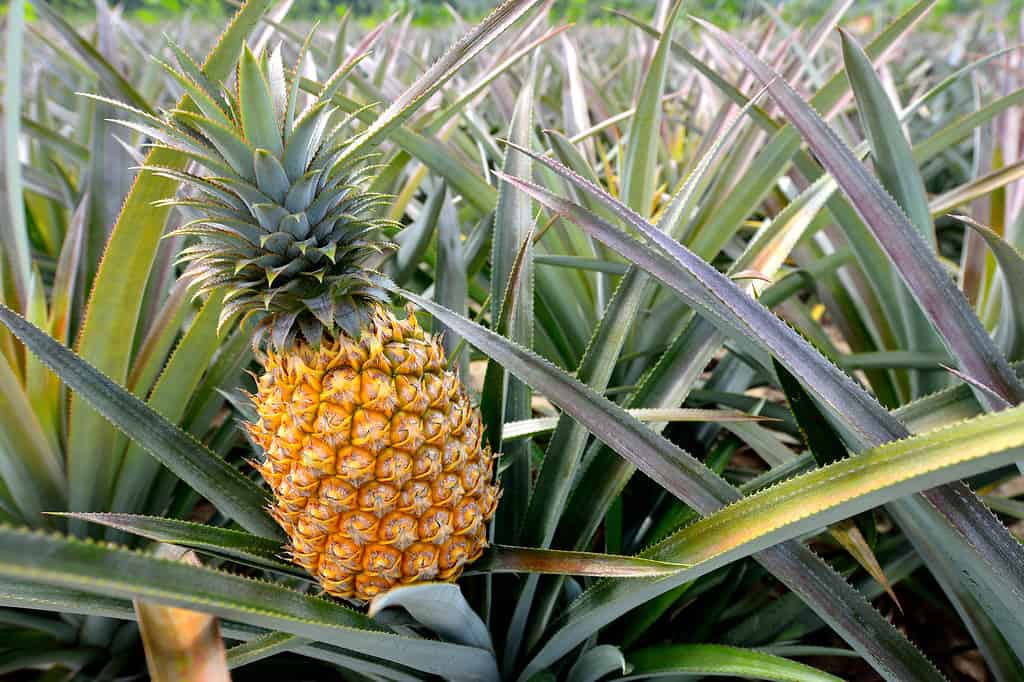
Pineapples are tropical plants that require warm temperatures.
©9comeback/Shutterstock.com
How to Grow Pineapples: Growing pineapples Indoors
Pineapple plants make excellent houseplants. However they do require a modicum of care and attention. Pineapple plants are tropical plants that benefit from warm temperatures and bright, indirect sunlight, making them ideal for growing indoors. When growing a pineapple plant indoors, it’s important to choose a well-draining pot and use a soil mix that is rich in organic matter. Pineapple plants also require regular watering and humidity, so it’s important to keep the soil moist and to mist the leaves regularly to maintain humidity levels. Fertilizing the plant with a balanced fertilizer once a month can also help promote healthy growth.
While pineapple plants can be slow-growing, taking several years to produce fruit, they can still be rewarding and enjoyable houseplants. The process of watching the plant grow and potentially produce fruit can be a fun experience for indoor gardeners.
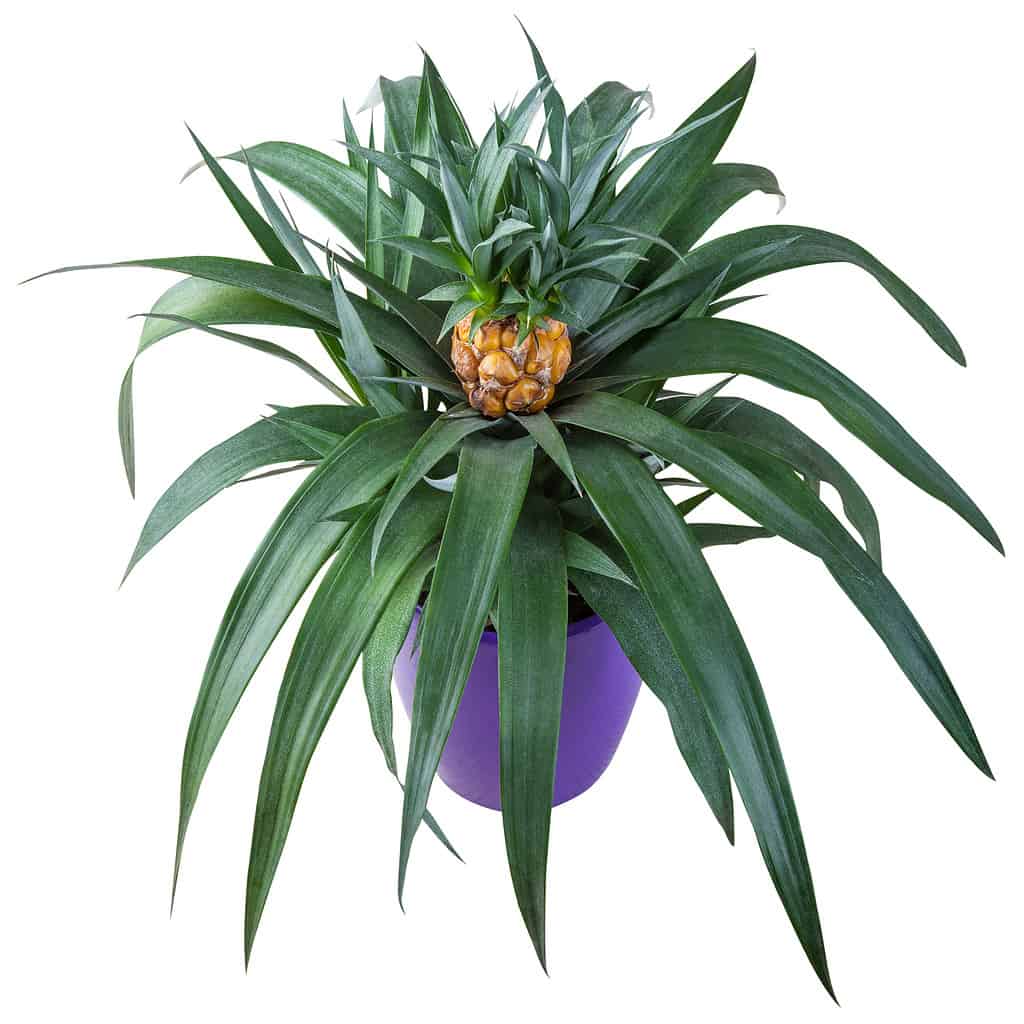
While pineapple plants can be slow-growing, taking several years to produce fruit, they can still be rewarding and enjoyable houseplants.
©Vadym Zaitsev/Shutterstock.com
Step-by-Step Guide for Growing Indoor Pineapple Plants
Selecting a Container
- Select an appropriate container: You will need a 5-7 gallons (18-26 L) container. This will provide enough space for the pineapple plant to grow and develop its roots. It’s also important to choose a container that has good drainage, as pineapple roots do not like to sit in waterlogged soil. Placing the container on a rolling plant stand allows for flexibility, making it easier to reposition your pineapple plant to ensure that it is getting enough sunshine. Rolling plant stands also make it easier to clean around the plant.
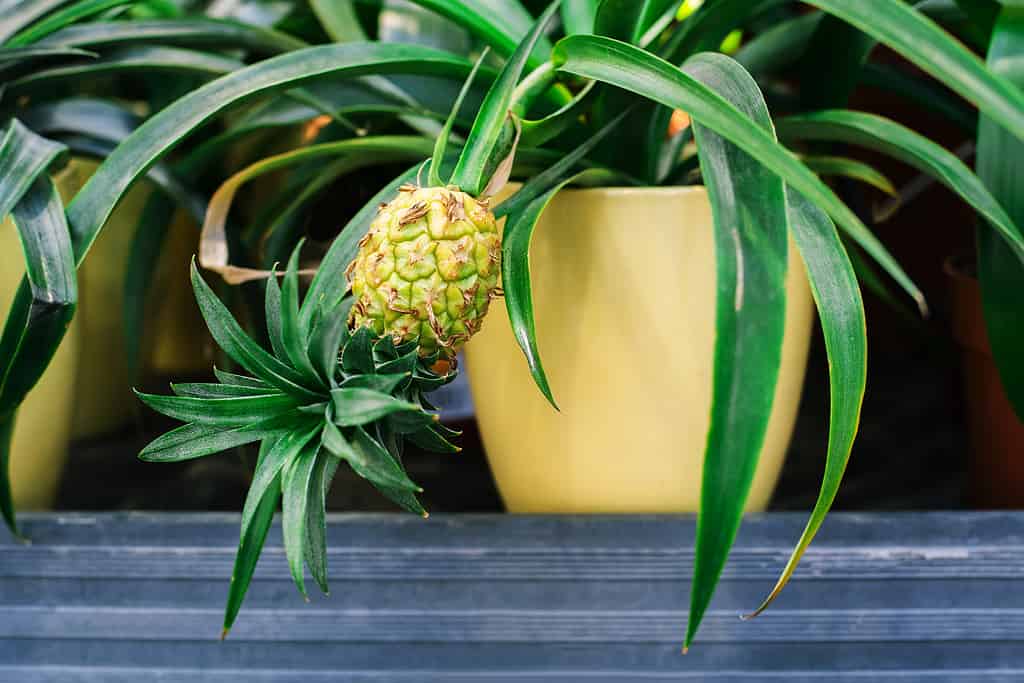
You will need a 5-7 gallons (18-26 L) container. This will provide enough space for the pineapple plant to grow and develop its roots.
©Dmitry Markov152/Shutterstock.com
Selecting a Pineapple
- Select a pineapple: Choose a fresh, healthy pineapple fruit with a crown of green leaves that is free of damage or bruising. The fruit should be ripe, but not overripe.
- Remove the crown: Cut off the top of the pineapple fruit, including the crown of leaves and about half an inch of the fruit flesh. Use a sharp knife to carefully remove any remaining fruit flesh from the bottom of the crown.
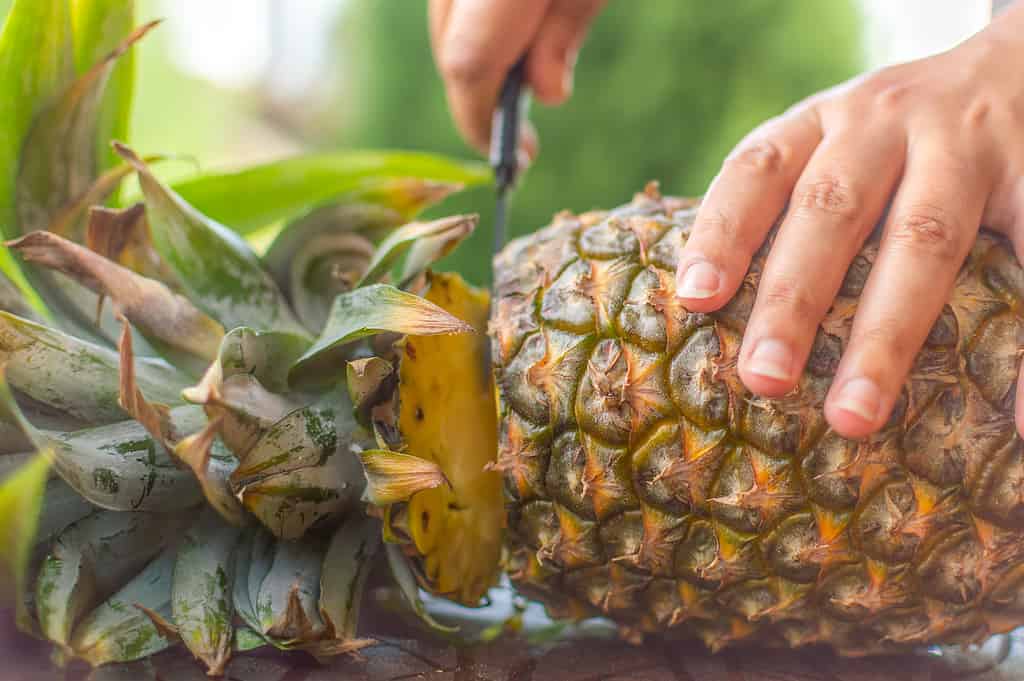
Cut off the top of the pineapple fruit, including the crown of leaves and about half an inch of the fruit flesh.
©mirbasar/Shutterstock.com
- Place the pineapple top in a jar or glass of water, making sure that the bottom of the stem is submerged in the water.
- Change the water every few days to keep it fresh and to prevent bacterial growth.

Change the water every few days to keep it fresh and to prevent bacterial growth.
©Geshas/Shutterstock.com
- After 2-3 weeks, you should see roots starting to form from the bottom of the stem.
- Once the roots are 1-2 inches long, its time to transplant the pineapple top.
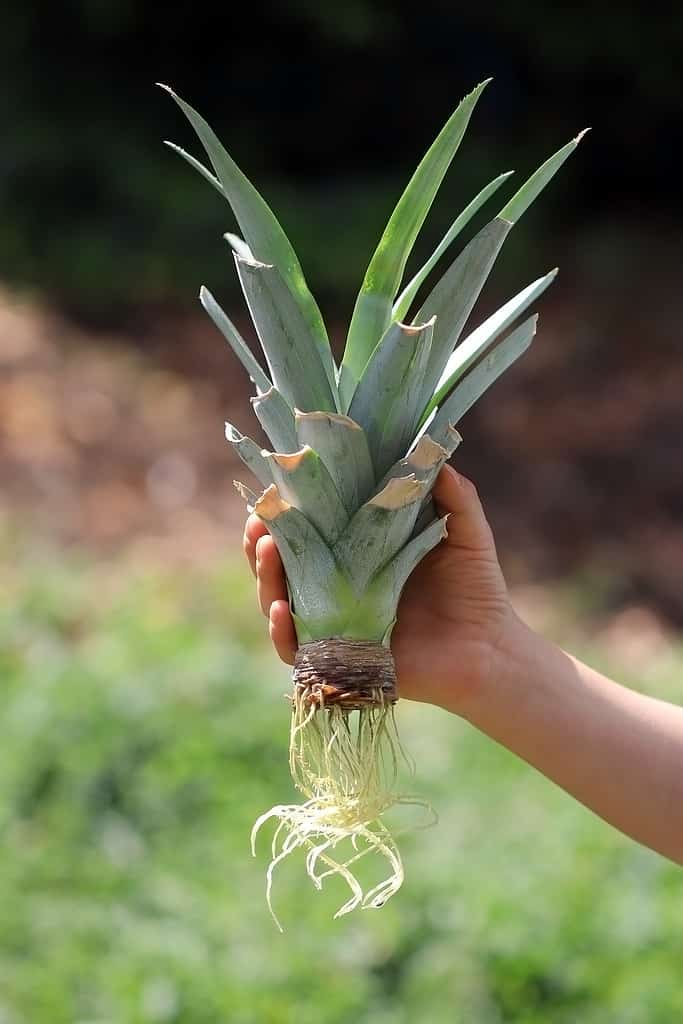
Once the roots are 1-2 inches long, its time to transplant the pineapple top.
©i-am-helen/Shutterstock.com
Planting Your Pineapple Plant
- Fill your pre-selected pot with a soil mix that is rich in organic matter. Water the soil lightly to moisten it.
- Plant the pineapple crown in the center of the pot, burying it about halfway into the soil. Press the soil gently around the base of the crown to secure it in place.
- Water the plant: Water the pineapple plant lightly to settle the soil and moisten the roots. Avoid overwatering, as this can cause the plant to rot.
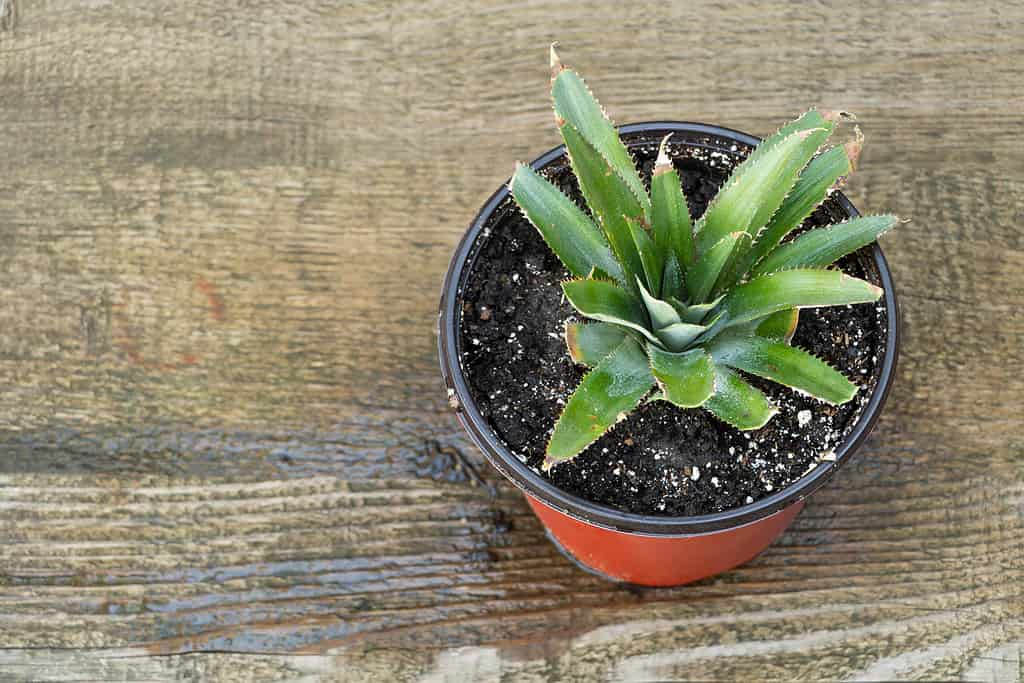
Plant the pineapple crown in the center of the pot, burying it about halfway into the soil.
©Gheorghe Mindru/Shutterstock.com
- Place the pot in a warm, sunny location where the pineapple plant can receive at least six hours of bright, indirect sunlight per day. A south-facing window or grow lights can provide sufficient light.
- Pineapple plants require minimal maintenance, but you may need to rotate the pot periodically to ensure even growth, and prune any dead or damaged leaves. Fertilize the plant with a balanced fertilizer once a month during the growing season, following the manufacturer’s instructions.
- Be patient! Pineapple plants are slow-growing and may take several years to produce fruit. In the meantime, enjoy the process of watching your plant grow and mature, and providing it with the care it needs to thrive.
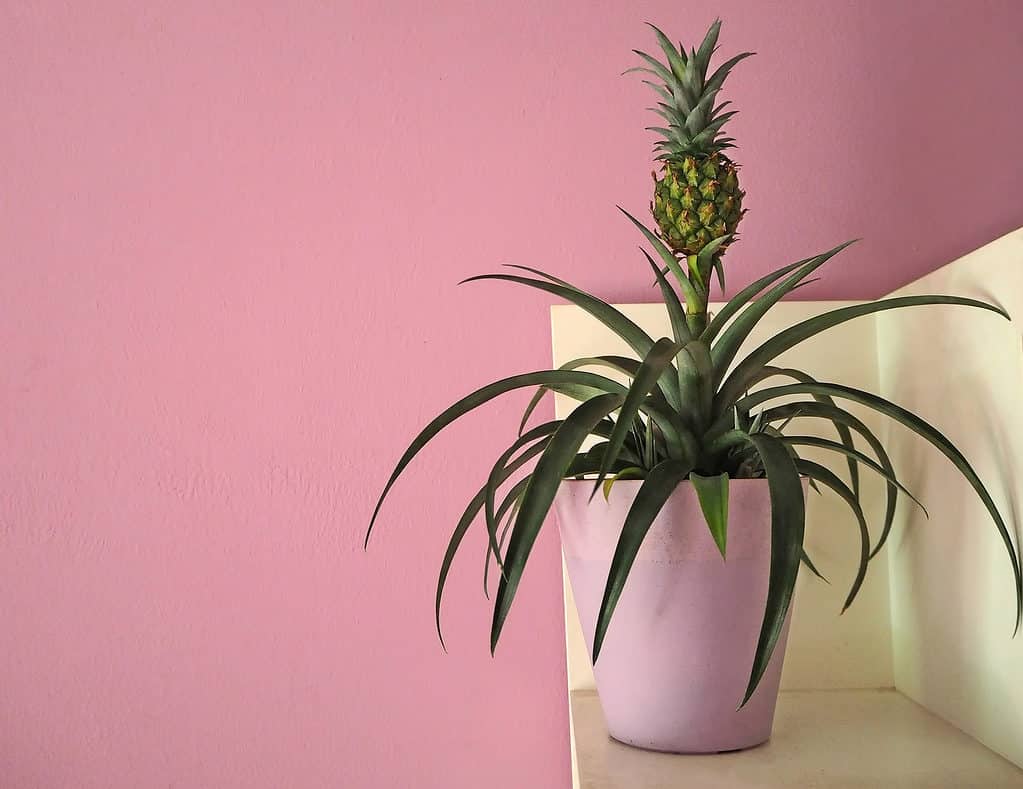
Pineapple plants are slow-growing and may take several years to produce fruit.
©iStock.com/Luca Piccini Basile
How to Grow Pineapples: Growing Pineapples Outdoors
If you live in a suitable climate for planting you pineapple plant outdoors, or you simply wish to add a bit of intrigue to your landscape by growing a pineapple plant as a annual, follow the above steps until it comes to the planting process. This is where the two methods diverge. Instead of preparing a container for your pineapple plant, you will need to prepare a garden space. Turn your garden soil, amending it as necessary to arrive at the acidic 4.5–5.6 pH level that pineapples require to thrive. Learn more about what soil ph levels mean and how to test your soil here.

Turn your garden soil, amending it as necessary to arrive at the acidic 4.5–5.6 pH level that pineapples require to thrive.
©iStock.com/kb79
Once the soil has been turned and amended, dig a hole that is slightly larger than the root ball of the pineapple plant. Plant the pineapple so that the base of the leaves is level with the soil surface. Gently tamp down the soil around the base of the plant to remove any air pockets.
Pineapple plants require regular watering to establish themselves and grow properly. Water deeply once a week, or more frequently during hot, dry weather. However pineapples, once established do not like wet roots, so allowing an established plant to dry out between waterings is considered a best practice.

Plant the pineapple so that the base of the leaves is level with the soil surface.
©Tnature/Shutterstock.com
Pineapple fruits typically take 18-32 months to mature, depending on the growing conditions. When the fruit is ripe, it will be fragrant and the flesh will be sweet and juicy. Cut the fruit off the plant using a sharp knife and enjoy!
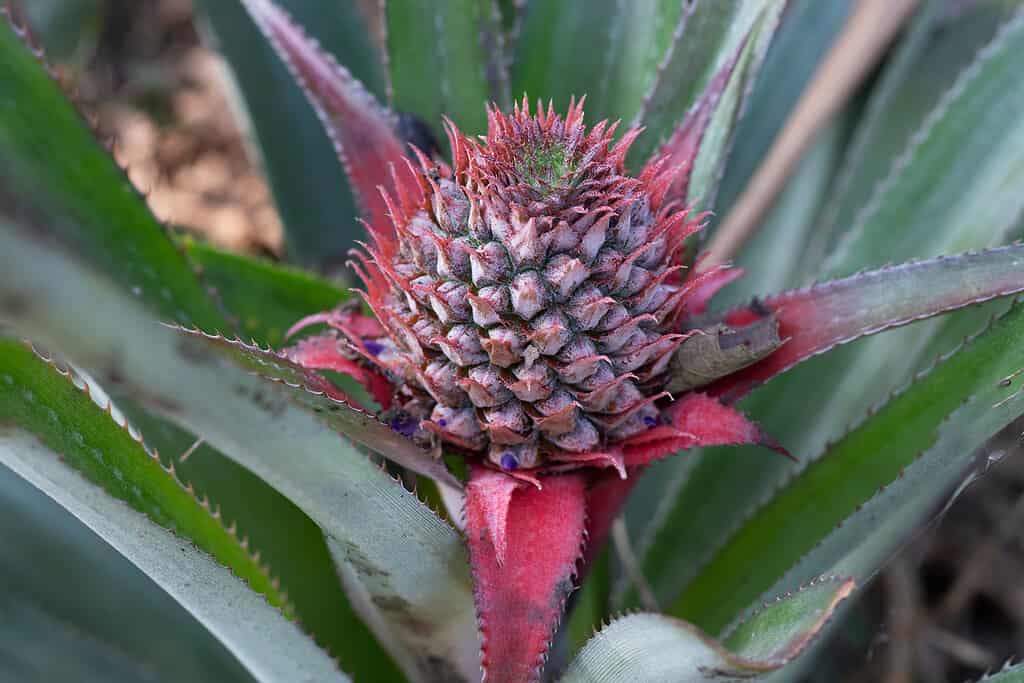
Pineapple fruits typically take 18-32 months to mature, depending on the growing conditions.
©7G Studio/Shutterstock.com
Five Fascinating Facts about Pineapples
- Pineapples have long been a symbol of hospitality and welcome, and were often displayed by European nobility as a sign of wealth and extravagance.
- Pineapples contain a unique group of enzymes called bromelain, which have anti-inflammatory and digestive properties, and are often used in natural medicine.
- Costa Rica produces more pineapples than any other country. They produce 70% of the world’s pineapples!
- Pineapple plants are self-pollinating and do not require cross-pollination to produce fruit. The flowers of the pineapple plant contain both male and female reproductive organs, so they are capable of self-fertilization.
- The Dole Plantation Pineapple Garden maze in Wahiawa, Hawaii was declared the largest pineapple garden maze in the world in 2008. The maze winds through over three acres of colorful tropical plants.
The photo featured at the top of this post is © iStock.com/Luca Piccini Basile
Thank you for reading! Have some feedback for us? Contact the AZ Animals editorial team.







